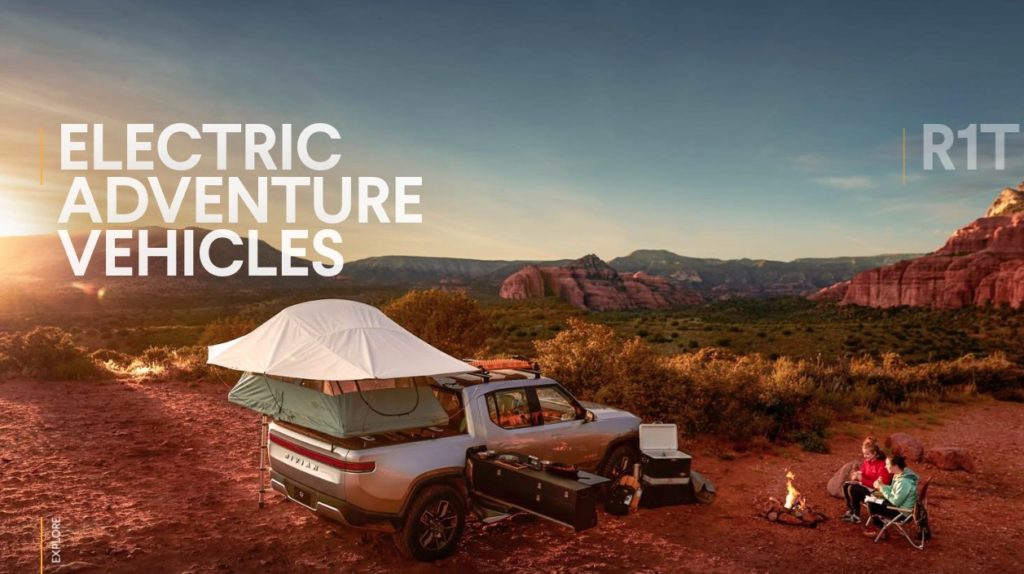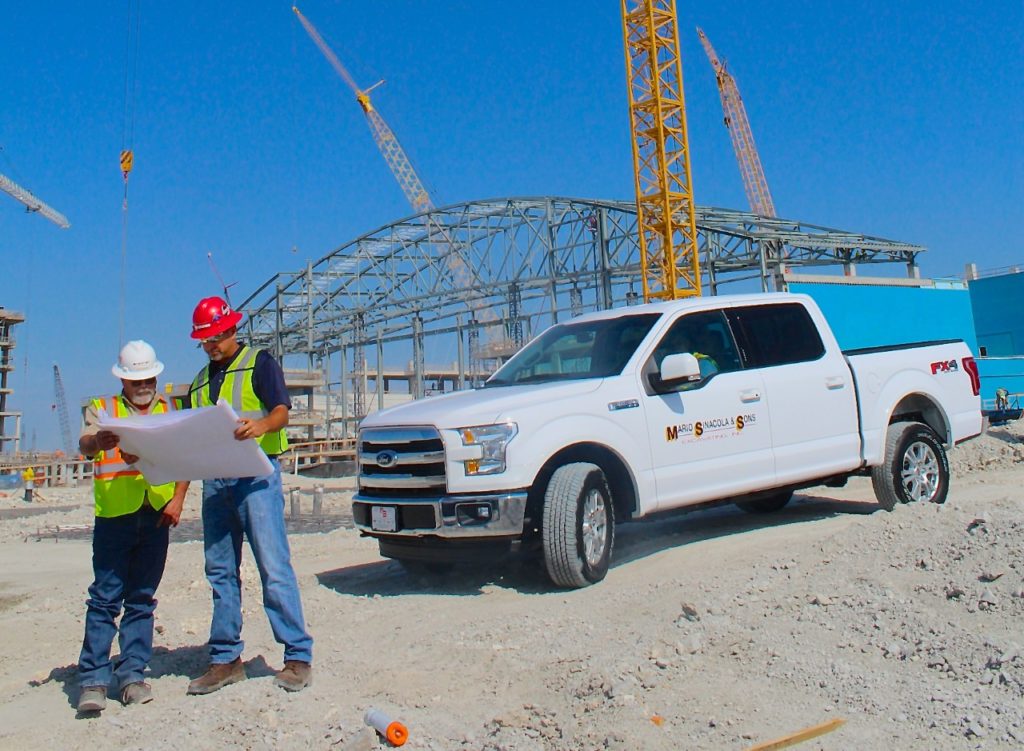I appreciate that Rivian carries with it an appreciation for the wild areas, the natural world, and going out into the mountains to enjoy life. I appreciate that Rivian’s staff goes to these places, and has their own ah-hah moment that their work in developing an electric pickup truck could possibly protect these wild places they love. I love those wild places as well. However, will building an “Adventure Truck” matter much in the overall scheme of emissions from the transportation fleet?
A year ago, Rivian unveiled the Rivian R1T billing it as an electric “Adventure Truck”. An Adventure Truck is the sort of pickup truck you take on off-roading adventures with mountain bikes or dirt bikes or skis or whatever to enjoy some wilderness. Of course these vehicles need a lot of range because there’s no charging stations in the wilderness, and they need ruggedness and a 4×4 drive train to handle off-road driving.
Today, Rivian unveiled the video attached at the bottom of this post. The video talks about all the same things, off-roading, driving range, ruggedness, the wild outdoors, etc. The video shows that the company now has a sizable team. It quotes some of those team-members expressing their love for the wild outdoors, and their hope that Rivian’s electric adventure truck will help to protect those places.
The problem is that the primary use-case for this class of vehicle is not adventure trucks. It is run-of-the-mill construction workers, and the vast number of Ford F-150’s that are sold into that market every year.
To protect the wilderness does not mean driving clean vehicles into the wilderness. Instead it means protecting the entire environment, by transforming all vehicles to be clean vehicles. The priority should be on the biggest market, namely the construction workers, rather than the adventure truck guys.
There is nothing new to this insight. About 100 years ago electric trucks were widely used in the USA and Europe, with 10’s of thousands of trucks used in dozens of American cities. In 1922 H. C. Cushing published the 10th edition of The Electric Vehicle Hand-Book![]() , a book discussing electric trucks in use in 1922, the technology, and the business case of operating electric trucks versus horse-drawn or gasoline-powered trucks. While the technology presented in the book is extremely primitive, the book makes an excellent business case for commercial electric trucks. In 1922.
, a book discussing electric trucks in use in 1922, the technology, and the business case of operating electric trucks versus horse-drawn or gasoline-powered trucks. While the technology presented in the book is extremely primitive, the book makes an excellent business case for commercial electric trucks. In 1922.
Let that sink in a moment. In 1922 electric trucks were widely used across the USA for delivery service and other commercial purposes.
Commercial-oriented investments into Rivian
Back in February, Amazon made an investment in Rivian. Presumably Amazon’s purpose was for Rivian to develop trucks to be used in Amazon’s delivery vehicle fleet. Amazon is developing a last-mile delivery service to bypass the likes of the USPS, UPS, FedEx and DHL. Amazon currently offers Sprinter vans to independent contractors for use in Amazon deliveries, and Amazon could certainly offer an electric truck for that purpose.
Similarly, in September, Cox Automotive made an investment in Rivian. When announcing the deal, RJ Scaringe, founder and CEO of Rivian said “As part of this, we are excited to work with Cox Automotive in delivering a consistent customer experience across our various touchpoints. Cox Automotive’s global footprint, service and logistics capabilities, and retail technology platform make them a great partner for us.”
And in April, Ford Motors invested $500 million in Rivian. Along with the investment, the two companies have committed to work together on developing an all-electric truck for Ford. Those of us with a long enough memory remember that Ford sold a Ranger EV back in the early ZEV Mandate days, and more recently sold an all-electric Ford Transit Connect the latter featuring a powertrain from a 3rd party company. The press release making that announcement did not talk about specific results, just a pledge to build a Ford-branded electric truck, and a suggestion that Ford believes “Rivian can benefit from Ford’s industrial expertise and resources.”
Amazon is looking for electric delivery trucks. Cox Automotive is looking for logistics trucks, which is a fancy word for delivery trucks. Ford Motors is looking for something not yet specified.
In other words, Rivian does understand the bigger issue – the need to develop a vehicle for commercial users. Why, then, does Rivian’s new video spend the entire time talking about adventure trucks? Why does the Rivian website feature adventure trucking, and not a whiff of information about commercial trucks?
Rivian keeps focusing on Adventure Trucks

This image from Rivian’s home page is what I mean. This couple looks like they’re having a great adventure. It demonstrates one of the uses for the storage space – a slide-out kitchen and cooking area. That’s ingenious, and something that comes from having a “clean slate” to work from.
It’s nice to think these people won’t be burning any fossil fuels while out in the wilderness. But does that truck see day-in-day-out usage? No. It doesn’t even see daily or weekly usage going to places like this. Instead this couple lives in suburbia, and the majority of their driving is commuting to a job, or grocery shopping.
A plea to focus on commercial truck use-cases
The folks who would use this sort of vehicle to its fullest are the construction workers I mentioned earlier.

Ford knows what this kind of truck is used for. This image comes from a Ford press release in 2015 talking about the history of Ford F-150 being used by working people for decades.
Yes this sort of truck needs to do some off-road driving. Construction workers often are assigned to an empty field and told to build something there. A truck built from Rivian’s “skateboard” could surely be used by these sort of construction workers. But they won’t care a thing about the uber-smooth-polished wood of the Rivian R1T dashboard.
- Is there enough Grid Capacity for Hydrogen Fuel Cell or Battery Electric cars? - April 23, 2023
- Is Tesla finagling to grab federal NEVI dollars for Supercharger network? - November 15, 2022
- Tesla announces the North American Charging Standard charging connector - November 11, 2022
- Lightning Motorcycles adopts Silicon battery, 5 minute charge time gives 135 miles range - November 9, 2022
- Tesla Autopilot under US Dept of Transportation scrutiny - June 13, 2022
- Spectacular CNG bus fire misrepresented as EV bus fire - April 21, 2022
- Moldova, Ukraine, Georgia, Russia, and the European Energy Crisis - December 21, 2021
- Li-Bridge leading the USA across lithium battery chasm - October 29, 2021
- USA increasing domestic lithium battery research and manufacturing - October 28, 2021
- Electrify America building USA/Canada-wide EV charging network - October 27, 2021











